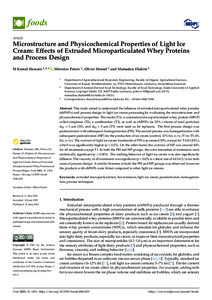| dc.date.accessioned | 2021-06-30T09:05:21Z | |
| dc.date.available | 2021-06-30T09:05:21Z | |
| dc.date.issued | 2021-06-21 | |
| dc.identifier | doi:10.17170/kobra-202106244158 | |
| dc.identifier.uri | http://hdl.handle.net/123456789/12950 | |
| dc.description.sponsorship | Gefördert durch den Publikationsfonds der Universität Kassel | ger |
| dc.language.iso | eng | eng |
| dc.rights | Namensnennung 4.0 International | * |
| dc.rights.uri | http://creativecommons.org/licenses/by/4.0/ | * |
| dc.subject | extruded microparticulation | eng |
| dc.subject | hot extrusion | eng |
| dc.subject | light ice cream | eng |
| dc.subject | pasteurization | eng |
| dc.subject | homogenization | eng |
| dc.subject | process techniques | eng |
| dc.subject.ddc | 600 | |
| dc.title | Microstructure and Physicochemical Properties of Light Ice Cream: Effects of Extruded Microparticulated Whey Proteins and Process Design | eng |
| dc.type | Aufsatz | |
| dcterms.abstract | This study aimed to understand the influence of extruded microparticulated whey proteins (eMWPs) and process design in light ice cream processing by evaluating the microstructure and physicochemical properties. The inulin (T1), a commercial microparticulated whey protein (MWP) called simplesse (T2), a combination (T3), as well as eMWPs (as 50% volume of total particles): d50 < 3 µm (T4), and d50 > 5 µm (T5) were used as fat replacers. The first process design was pasteurization with subsequent homogenization (PH). The second process was homogenization with subsequent pasteurization (HP) for the production of ice cream (control, 12% fat, w/w; T1 to T5, 6% fat, w/w). The overrun of light ice cream treatments of PH was around 50%, except for T4 (61.82%), which was significantly higher (p < 0.01). On the other hand, the overrun of HP was around 40% for all treatments except T1. In both the PH and HP groups, the color intensities of treatments were statistically significant (p < 0.001). The melting behavior of light ice cream was also significantly different. The viscosity of all treatments was significant (p < 0.05) at a shear rate of 64.54 (1/s) for both cases of process design. A similar firmness in both the PH and HP groups was observed; however, the products with eMWPs were firmer compared to other light ice creams. | eng |
| dcterms.accessRights | open access | |
| dcterms.creator | Hossain, M. Kamal | |
| dcterms.creator | Petrov, Miroslav | |
| dcterms.creator | Hensel, Oliver | |
| dcterms.creator | Diakité, Mamadou | |
| dc.relation.doi | doi:10.3390/foods10061433 | |
| dc.subject.swd | Strangpressen | ger |
| dc.subject.swd | Speiseeis | ger |
| dc.subject.swd | Pasteurisieren | ger |
| dc.subject.swd | Homogenisieren | ger |
| dc.subject.swd | Verfahrenstechnik | ger |
| dc.subject.swd | Molkenproteine | ger |
| dc.type.version | publishedVersion | |
| dcterms.source.identifier | eissn:2304-8158 | |
| dcterms.source.issue | Issue 6 | |
| dcterms.source.journal | Foods | eng |
| dcterms.source.volume | Volume 10 | |
| kup.iskup | false | |
| dcterms.source.articlenumber | 1433 | |


